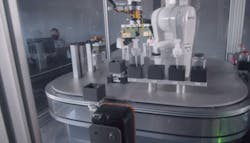In a demonstration at PACK EXPO Connects, Derrick Stacey, product manager at B&R North America, explained how machine-centric robotics (MCRs) can add flexibility and adaptability to production and packaging and operations.
A key aspect of B&R’s approach to MCR is its merging of the robot controller into the machine controller so that users can manage servo control, I/O, and visualization from one industrial PC to drive ABB's portfolio of manipulators. The integration of ABB's robot manipulators with B&R’s control platform enables users to speed up cycle times, minimize dwell times, and eliminate extra hardware like external encoders for tracking, according to Stacey. (Editor’s note: ABB acquired B&R in 2017.)
This integration of technologies “physically simplifies cabinet wiring and decreases the footprint of electrical cabinets,” Stacey said. “Functionally, this eliminates communication interfaces, timing delays, and multiple programming interfaces while opening opportunities for real-time synchronization, recipe-driven changeovers, and simplified diagnostics.”
Stacey explained that a key industry driver behind ABB’s and B&R’s pursuit of the MCR concept is that they are seeing more and more customers retrofitting machines once developed for a single product to accommodate additional SKUs developed long after the system was initially put into production. “These on-the-floor changes drive down the OEE of equipment and make for a repair and maintenance nightmare,” he said. “B&R sees integration of robots into a machine’s architecture as a way to help future-proof almost any system and can simplify the management of the constant changeovers needed to run all the necessary SKUs to meet customer orders. This can be a crucial competitive edge as e-commerce becomes a larger share of almost all consumer packaged goods companies’ revenues and future growth.”
With a single control architecture, the servo information can be shared over B&R’s PowerLink “real-time and deterministic Ethernet protocol at sub-millisecond speeds for fast, on-the-fly interactions with the robot without the need for any special compensation or homegrown algorithms,” Stacey said. “This can have a direct effect on productivity and push equipment OEE to a world-class level.”
He added that the entire suite of ABB robot functionality is provided through B&R’s mapp robotics software—a set of standard function blocks to which B&R is constantly adding new features and capabilities. The software can be programmed using industry standard languages like ladder logic and structured text as well as all the other IEC 61131 languages.
“Setting up an ABB manipulator in Automation Studio—B&R's integrated development environment—is a single step drag-and-drop process,” Stacey said. “Select your manipulator from the toolbox and drop it into the system designer. Behind the scenes on the drives, configurations and parameters are brought in automatically so that users can be up and running and jogging the robot in minutes.”
B&R’s MCR platform comes with a set of continuously updated process level components. Providing an example, Stacey said, “we have a pick-and-place component, where a user can configure the process and material flow for a range of pick-and-place use cases. This includes multiple robots, multiple products, and multiple conveyors all working in coordination to get orders filled.”
Stacey also noted that having the added intelligence provided to the manipulator by the rest of the B&R control system means that “we can track wear on parts and add periodic maintenance to the growing list of jobs that the robot can perform without any operator interaction. Moving to a just-in-time maintenance scheme versus planned maintenance can increase the uptime for almost any system without increasing the risk of unplanned stoppages.”


